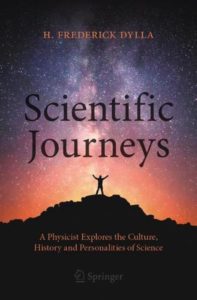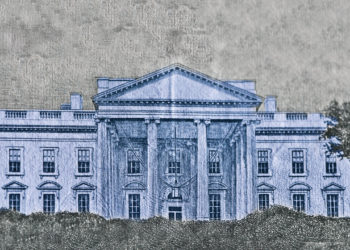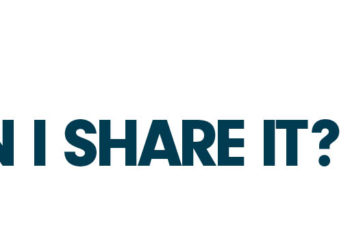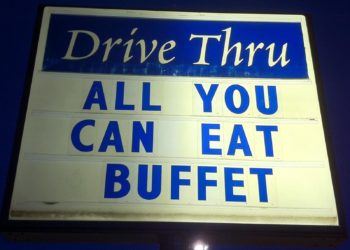In reading Fred Dylla’s Book, Scientific Journeys: A Physicist Explores the Culture, History and Personalities of Science, I lost my sense of time and space. I found myself remembering what it is like to be a kid — feeling the wonder and excitement of science, imagining what our future may look like.
 Fred Dylla, Executive Director Emeritus of the American Institute of Physics (AIP) is still such a kid, and dare I say it, somewhat of a polymath. Yes, Fred is a physicist, making fundamental contributions across a range of fields from fusion energy to particle and nuclear physics. Fred has also played a large role in steering the field of physics through his work at the helm of AIP, and as such has influenced science policy and the evolution of scientific publishing. What is perhaps most unusual and wonderful about Fred is the way he sees science not only as fundamental in itself, but also in how it extends into other ways of knowing, reaching into the arts and humanities, as well as the role that science plays as a cultural force in the world. Fred’s essays are on the one hand intriguing, and on the other hand full of moments where you say to yourself, “I just did not know that.”
Fred Dylla, Executive Director Emeritus of the American Institute of Physics (AIP) is still such a kid, and dare I say it, somewhat of a polymath. Yes, Fred is a physicist, making fundamental contributions across a range of fields from fusion energy to particle and nuclear physics. Fred has also played a large role in steering the field of physics through his work at the helm of AIP, and as such has influenced science policy and the evolution of scientific publishing. What is perhaps most unusual and wonderful about Fred is the way he sees science not only as fundamental in itself, but also in how it extends into other ways of knowing, reaching into the arts and humanities, as well as the role that science plays as a cultural force in the world. Fred’s essays are on the one hand intriguing, and on the other hand full of moments where you say to yourself, “I just did not know that.”
Scientific Journeys is a collection of prose pieces that portray the author’s approach to a world of science and the science of the world. There are fascinating stories, some of which I will highlight here, that are part imparting knowledge, part ruminating on culture, and part revealing of the author’s innate wonder at the world around him.
I found myself reminded of two books that were formative for me. The first is a collection of thoughts and reflections from the Nobel Prize-winning poet, Wislawa Szymborska, entitled Nonrequired Reading: Prose Pieces. While this book is not about science, her ability as a writer to reveal what excites her, or thoughts about the world around us, struck a chord with me as I read Fred Dylla’s book. The second book, which I would recommend to any young person thinking about a career in science, is Peter Medawar’s Book, Advice to a Young Scientist, where Medawar delves into what it means to be a scientist, and how to think — often employing his wry sense of humor. Both these books have the same common thread as Scientific Journeys in piecing together facts and stories in a way that reveals much about the author.
Let’s look at some of the stories in the book. By the way, there is no need to read this book in chapter order — I would start with Part II, Mentors and Milestones. The first chapter in this section is entitled “Exciting the Imagination: My First Laser”. We quickly are drawn into the life of Fred as a young boy “captivated” by reading a Popular Science Magazine article entitled “The Incredible Ruby Ray”, which led Fred to his first scientific mission – to build his own laser. This story highlights the critical role of his teachers’ encouragement and support, emphasizing the importance of mentoring for young scientists.
“My fascination with lasers began as a 13-year old in 1962, cobbling together enough materials and equipment from very generous mentors to build my own laser. That experience convinced me to study and work hard enough to become and spend my life as a physicist.”
Fred was not shy: one revealing story tells how he wrote to one of the world’s experts of the effects of radiation in biological materials, the Nobel prize winner for physiology, Professor Hermann Muller of Indiana University. Fred wrote to Professor Muller, asking some pointed questions on whether visible laser radiation may have interesting biological effects when enhanced with a dye molecule. Muller wrote back to this 15-year old kid, in a three-page letter detailing tutorials, thoughts and ruminations, ideas for further reading, and suggestions for experiments.
On culture, I was truck by the chapter entitled “The Master Teacher”. In this section, Fred describes how important his mentor and teacher, MIT Physics Professor John C. King was to his own career. He posits that many scientists can name a special teacher who had an extraordinary influence on their life. Perhaps at the root of the inspiration Fred found in John King is summed up by this quote by King from the book:
His belief that anyone could “find something interesting to study about any mundane effect.”
Many of Fred’s tales describe famous, and not-so-famous characters in the history of physics. Fred’s style here is to whet your appetite, and expect you to then go elsewhere and find out more. A good example of this may be seen in Fred’s chapter entitled “My Encounters with the Queen of Carbon”, describing his long association with 2014 National medal of Freedom awardee, Mildred (Millie) Dresselhaus
Fred also discusses his other life, which is entrepreneurial and policy-oriented. Fred knows a lot about scientific publishing, especially through his work at the AIP on AIP’s and its member societies’ physics journals. It is clear that Fred is a pragmatic entrepreneur who sees the value of the publishing enterprise, and realized that he could help bridge some of the cavernous divides between stakeholders in scientific publishing, especially on the topic of how to accomplish public access to scientific content. Fred was asked by a member of the US Congress in 2009 to help organize and convene the Scholarly Publishing Roundtable. The Roundtable’s “…charge was to provide recommendations to the Federal Government on how to accomplish public access to the results of federally funded research…” Without going into detail on the detailed work of the Roundtable, what stands out is the collaborative nature of the work done by a diverse group of Roundtable members, where consensus was likely hard-won. Two excellent articles in May 2022 by Rick Anderson here in The Scholarly Kitchen delve further into the work of the Scholarly Publishing Roundtable: “10 Years of Public Access to the Results of Federally Funded Research: An Interview with the Scholarly Publishing Roundtable” (Part 1, and Part 2)
I could of course write more about the book. I do highly recommend you read Scientific Journeys: A Physicist Explores the Culture, History and Personalities of Science. Instead, at this point I thought it would be interesting to ask Fred Dylla a few questions, less about the contents of the book and more about what makes Fred tick.
It is quite clear that your life as a “Sputnik Kid” was formed early on. Can you tell us a little bit about what it felt like to be a young boy hooked on science, and especially the idea of laser physics?
I was a sputnik kid long before I was spellbound by the invention of the laser. Sputnik was launched in 1957 when I was eight years old and like millions of kids all over the world, I became fascinated by the prospect of exploring space with real rockets and real satellites versus the stuff of science fiction. The launch of this first satellite by the Soviet Union also spurred considerable spending by the US government in science programs and increased spending on science education. I started reading lots of books and popular magazines about space exploration, but also other topics in science: minerals, fossils, and chemistry. Television was terrible in the late 50s and early 60s. About the only science program on for kids and teens featured a dedicated science teacher from Wisconsin, Don Herbert, who wrote and starred in the “Watch Mr. Wizard” series. This show went on for 14 years starting in 1951. I remember being fascinated by an episode where he demonstrated the concept behind nuclear fission by staging ping-pong balls on mousetraps. By the time I was 10 or 11, I had discovered Popular Science and Scientific American. I had trouble getting through issues of the latter publication until I was a few years older, but both magazines gave me plenty of scientific invention and discovery to chew on. By the time Popular Science ran an article in 1962 on the invention of the laser entitled “The Incredible Ruby Ray”, I was hooked, and I knew at that point I just had to build a laser for myself, and I never wavered from the goal that I was going to be a physicist.
It seems clear from reading your book that you had a series of mentors that helped shape you as a scientist and broad thinker. Can you tell us a little about some of your key mentors and how that shaped your worldview?
The days of a “lone wolf” scientist or engineer or entrepreneur died out with Thomas Edison with his invention of the modern industrial laboratory (which is one reason Edison has always been one of my heroes). I was fortunate to have a series of teachers and mentors who had an outsized influence on my education and career development. I give credit to two remarkable teachers from my high school, John D. Jones who taught me the rudiments of biology and Fred Schwartz who helped me undo some bad habits I learned playing with my first chemistry set (in the days where these sets contained real and dangerous chemicals).
I was fortunate to study and work with two dedicated teachers and innovative researchers during my entire undergraduate and graduate studies. Professors John G. King and Rainer Weiss of MIT taught me how to do research and what it means to be a physicist working in a scientific team — whether a small group of graduate students or a major international scientific project. Later in my career, another MIT professor, Millie Dresselhaus was an inspiration and a guidepost throughout my entire career including my last (paid) career stop, as CEO of the American Institute of Physics. Hermann Grunder who served as a director at three Department of Energy U.S. National Labs, taught me how to manage large groups of scientific talent. And then there are personalities who were not aware that their work guided my career, like Amar Bose at MIT, Steve Jobs from Apple, Robert Campbell from Wiley, and my artist friend from Truro, Massachusetts, Bill Evaul.
So, whenever I cross paths with a student who expresses an interest in science I try to be as helpful and patient as possible knowing I could be a mentor to them and knowing how important mentors have been to my career at all stages.
If you were to give just two pieces of advice to a young scientist, what would they be?
My best advice: (1) develop strong communications skills in both written and public speaking engagements and (2) develop team building skills for any size endeavor.
In any endeavor scientific or otherwise, communicating your ideas clearly, concisely, and accurately is essential for forward motion. Very few people are born great writers or speakers — these are skills to be learned and developed. Contemporary scientific research and global business endeavors require the ability to work and build team efforts. Find mentors who know the value of communication and team building skills and are patient with your learning curve.


